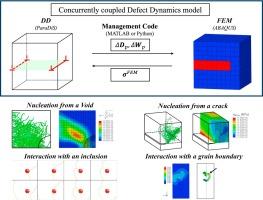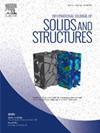Defect dynamics modeling of mesoscale plasticity
IF 3.4
3区 工程技术
Q1 MECHANICS
International Journal of Solids and Structures
Pub Date : 2024-11-07
DOI:10.1016/j.ijsolstr.2024.113132
引用次数: 0
Abstract
The collective motion of defects and their interaction are the basic building blocks for plastic deformation and corresponding mechanical behaviors of crystalline metals. Especially, dislocations among various defects are the “carrier” of plastic deformation in many crystalline materials, particularly ductile materials. To get a fundamental understanding of plastic deformation mechanisms, it calls for an integrated computational platform to simultaneously capture detailed defects characteristics across several length scales together with corresponding macroscopic mechanical response. In this paper, we present a three-dimensional mesoscale defect dynamics model to directly couple the three dimensional discrete dislocation dynamics model with continuum finite element method, aiming at capturing both size dependent plasticity at micron-, and submicron scale and constitutive behaviors at larger scales where such size-dependence disappear. Using non-singular dislocation theories, our model could accurately consider both short- and long-range elastic interactions between multiple dislocation segments with even higher computational efficiency than traditional dislocation dynamics simulations, together with the careful consideration of crystal/material rotation in the coupled framework. In addition, our model could directly model dislocation nucleation from stress concentrators such as a void, crack and indentor tip, which could allow us to investigate various defects’ motion and their mutual interactions, predicting macroscopic mechanical response of complex structures. The developed concurrently coupled model could also consider multiphysical phenomena by solving coupled governing equations in finite element framework, which could shed light on complex defect behaviors under various physical environments.

中尺度塑性缺陷动力学建模
缺陷的集体运动及其相互作用是结晶金属塑性变形和相应机械行为的基本组成部分。特别是在许多晶体材料,尤其是韧性材料中,各种缺陷之间的位错是塑性变形的 "载体"。为了从根本上了解塑性变形机制,需要一个综合计算平台,以同时捕捉多个长度尺度上的详细缺陷特征和相应的宏观力学响应。在本文中,我们提出了一种三维中尺度缺陷动力学模型,将三维离散位错动力学模型与连续有限元方法直接结合起来,旨在捕捉微米和亚微米尺度上的尺寸依赖性塑性以及尺寸依赖性消失的更大尺度上的构成行为。我们的模型采用非鞘状位错理论,能准确地考虑多个位错段之间的短程和长程弹性相互作用,其计算效率甚至高于传统的位错动力学模拟,同时在耦合框架中仔细考虑了晶体/材料的旋转。此外,我们的模型可直接模拟来自空洞、裂缝和压痕尖端等应力集中点的位错成核,从而研究各种缺陷的运动及其相互影响,预测复杂结构的宏观力学响应。所开发的并行耦合模型还可以通过在有限元框架内求解耦合控制方程来考虑多物理现象,从而揭示各种物理环境下的复杂缺陷行为。
本文章由计算机程序翻译,如有差异,请以英文原文为准。
求助全文
约1分钟内获得全文
求助全文
来源期刊
CiteScore
6.70
自引率
8.30%
发文量
405
审稿时长
70 days
期刊介绍:
The International Journal of Solids and Structures has as its objective the publication and dissemination of original research in Mechanics of Solids and Structures as a field of Applied Science and Engineering. It fosters thus the exchange of ideas among workers in different parts of the world and also among workers who emphasize different aspects of the foundations and applications of the field.
Standing as it does at the cross-roads of Materials Science, Life Sciences, Mathematics, Physics and Engineering Design, the Mechanics of Solids and Structures is experiencing considerable growth as a result of recent technological advances. The Journal, by providing an international medium of communication, is encouraging this growth and is encompassing all aspects of the field from the more classical problems of structural analysis to mechanics of solids continually interacting with other media and including fracture, flow, wave propagation, heat transfer, thermal effects in solids, optimum design methods, model analysis, structural topology and numerical techniques. Interest extends to both inorganic and organic solids and structures.

 求助内容:
求助内容: 应助结果提醒方式:
应助结果提醒方式:


